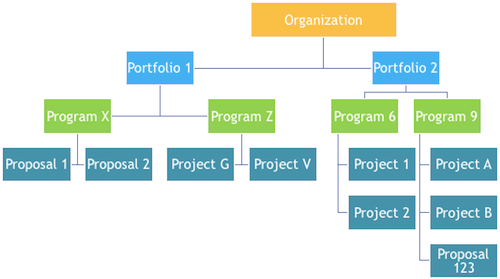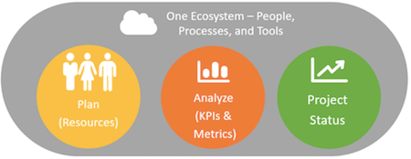Project Management Maturity
Achieving a strategic level of project management maturity should be on the mind of every project-based business, especially professional services firms.

Achieving a strategic level of project management maturity should be on the mind of every project-based business, especially professional services firms. Proposals, budgets, resources, estimate-at-complete (EAC) are activities a project-based business can’t live without. In a perfect world, the project management activities will connect directly to time and financial systems. The integrated system (people, processes, and tools) will provide a level of visibility and control that will help mature your discipline and will improve execution success.
Project Management Maturity = Project Success and Predictability
Evolving the Project Management Discipline
Since project management depends on the strategic alignment of people, processes and tools it only makes sense to concentrate on the level of competency of each of these attributes throughout your capability evolution. Professional services organizations are all on different journeys as it pertains to capability evolution. Which one of the below levels accurately depicts your current maturity status?
Level 1 - AD-HOC
Achieving goals depend on individual effort and heroics. This is typically chaos and you might picture this state as people running around with their hair on fire.
Level 2 - BASIC INFORMATION
Basic project management processes are in place and the necessary process discipline exists to repeat earlier successes on projects with similar applications.
Level 3 - ORGANIZATIONAL STANDARDS
Processes are documented and standardized, with approved tailored approaches adopted as needed.
Level 4 - QUANTITATIVE
Detailed measures on process adherence and cost/schedule performance are quantitatively measured, understood and managed.
Level 5 - CONTINUOUS IMPROVEMENT
Continuous process improvement is enabled by quantitative feedback from the process and from piloting innovative ideas and technologies.
By committing to mature your project management discipline you will realize the following benefits:
- Improved visibility and control into project performance
- Improved predictability and understanding of overall performance
- Increase in realized profitability
- Common organizational standards ensuring consistent reporting, reduction of rework, and reduced dependence on heroes.
- Optimization of the project management staff allowing them to focus on their customer, not on turning the crank.
- More efficient communication within project teams and to senior leadership.
- Delivery of real-time insight on project financials and enable resolution of identified risks.
- More on-time and on-budget projects, which equals a delighted customer.
What is PPM?
Today we hear so much about PPM, but what exactly is it and how many organizations are really doing it effectively? What makes implementation of this discipline so difficult? The root cause is disparate systems and lack of process standardization make reporting and managing projects and portfolios very challenging.
So, what is PPM? Wikipedia does a great job on the definition: “PPM is the centralized management of the processes, methods, and technologies used by project managers and project management offices (PMOs) to analyze and collectively manage current or proposed projects based on numerous key characteristics. The objectives of PPM are to determine the optimal resource mix for delivery and to schedule activities to best achieve an organization’s operational and financial goals, while honoring constraints imposed by customers, strategic objectives, or external real-world factors.”

Portfolios are groupings of projects that have common characteristics (example: customer, product line, etc.). The portfolio will not change, but the underlying projects and proposals will continue to change and evolve. The art of PPM is to plan resources, analyze data and resultant KPIs, and understand each project’s status all in one ecosystem (people, process, and tools).

6 Steps to Implement PPM:
- Get buy-in from all stakeholders: executives, functional leaders, portfolio managers, project managers all need to agree or at least understand the vision and the reason for PPM.
- Build a team with champions. Make sure you pick a team with the necessary expertise and if you don’t have the necessary expertise, consider hiring an outside firm. If you have a centralized project management office (PMO), they can be a huge help in providing expertise and direction for the PPM implementation team.
- Begin collecting project and program data in a central repository. An integrated project portfolio management tool will make a significant difference in the availability and accuracy of the data used for decision making.
- Common processes for all projects for the organization is a MUST. Processes must be current and realistic, and teams need role-based training. Projects all have nuances, so it is important to have tailorable processes to accommodate project size and type. The implementation team should lead this charge along with the PMO.
- Establish portfolios (in accordance with strategy) and align the projects to them. Assign portfolio managers and assure portfolio reporting is available. Common KPIs should be established with visual dashboards for the portfolio management team.
- Roll-out the discipline of PPM. Advertise to the organization and provide role-based training for all stakeholders throughout the organization.
Benefits of PPM:
- Common communication of business information produced from sound processes, assuring decisions are made based on accurate information that aligns with corporate goals
- Ability to manage the opportunity pipeline of all projects that can be rolled up to program and portfolio
- What-iffing and modeling aids decision making by allowing you to establish the best path for the business. Revenue, cash, project, new orders, and growth are a few financial metrics that support strategy
- Enterprise planning of resources assuring right resources, right time, and right place
- Analyze KPIs at all levels of the organization and communicate to the enterprise
- Portfolio reporting and drill down so that the status of all projects can be analyzed as a part of the overall portfolio
- Visibility into all the projects in a portfolio making sure that all projects are performing to expectations
- Common governance of projects and programs allowing for a repeatable and tailorable process for all project sizes and types.
Unanet Can Help You Get Started with PPM
What better way to achieving project management maturity than with project management software supporting your projects? Unanet’s Project Portfolio and Project Portfolio Financials software offer one single source of truth for every aspect of your projects: expense reporting, budgeting and forecasting, time reporting, pipeline management, and more. We’ve helped over 2,000 customers transform their project management processes. See Unanet in action by contacting our sales team.
Download our white paper, “Benefits of Maturing Your Project Management Discipline” to learn more.